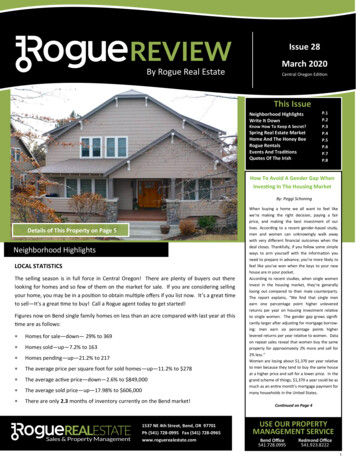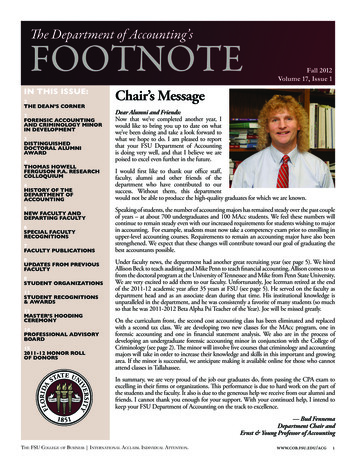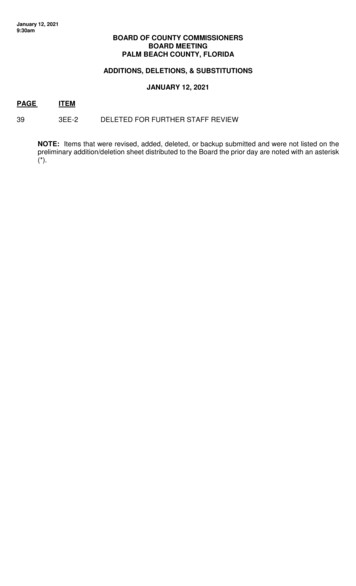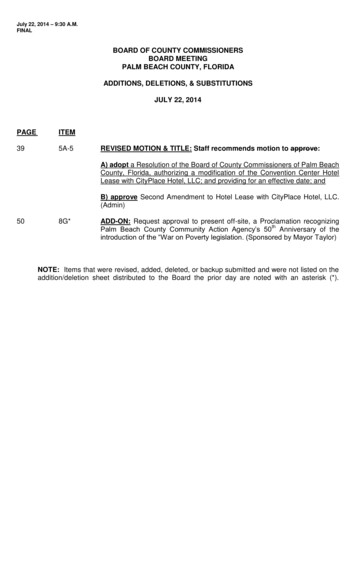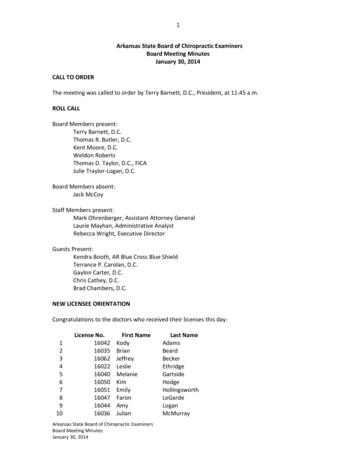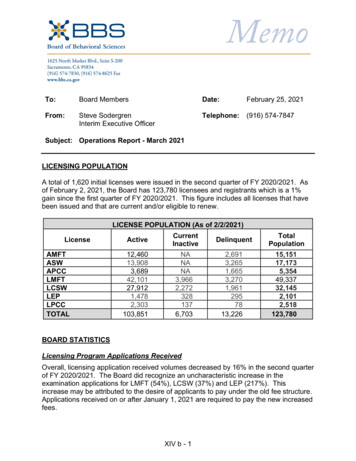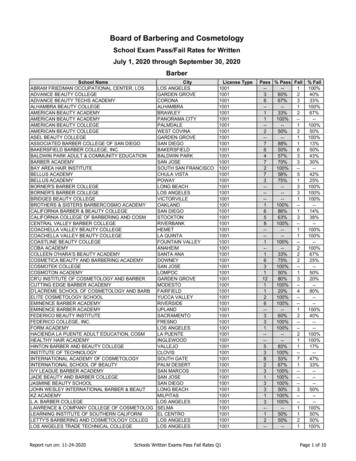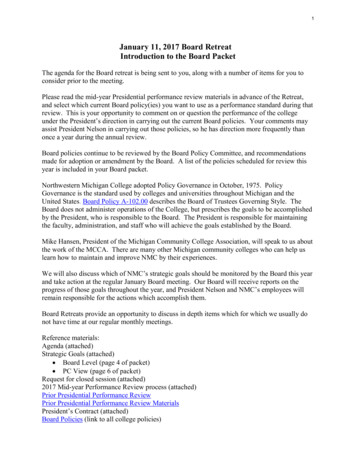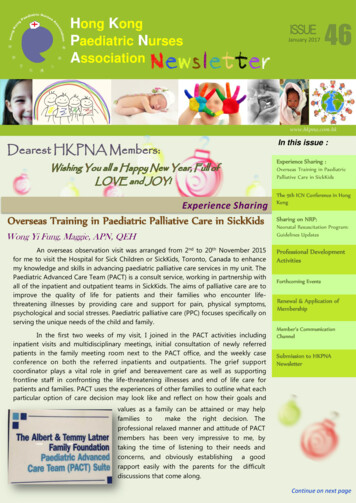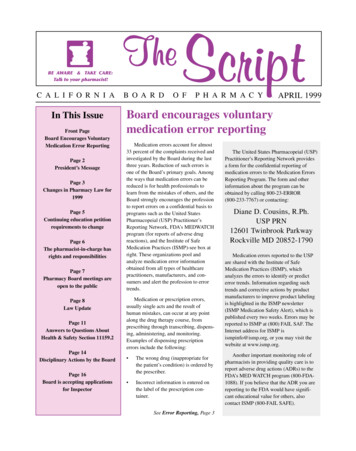
Transcription
BE AWARE. f'Talk to your pharmac,s C A L I F O R N I AIn This IssueFront PageBoard Encourages VoluntaryMedication Error ReportingPage 2President’s MessagePage 3Changes in Pharmacy Law for1999Page 5Continuing education petitionrequirements to changePage 6The pharmacist-in-charge hasrights and responsibilitiesPage 7Pharmacy Board meetings areopen to the publicPage 8Law UpdatePage 11Answers to Questions AboutHealth & Safety Section 11159.2LB O A R DO FP H A R M A C YJANUARY1999APRIL 1999Board encourages voluntarymedication error reportingMedication errors account for almost33 percent of the complaints received andinvestigated by the Board during the lastthree years. Reduction of such errors isone of the Board’s primary goals. Amongthe ways that medication errors can bereduced is for health professionals tolearn from the mistakes of others, and theBoard strongly encourages the professionto report errors on a confidential basis toprograms such as the United StatesPharmacopeial (USP) Practitioner’sReporting Network, FDA’s MEDWATCHprogram (for reports of adverse drugreactions), and the Institute of SafeMedication Practices (ISMP)-see box atright. These organizations pool andanalyze medication error informationobtained from all types of healthcarepractitioners, manufacturers, and consumers and alert the profession to errortrends.Medication or prescription errors,usually single acts and the result ofhuman mistakes, can occur at any pointalong the drug therapy course, fromprescribing through transcribing, dispensing, administering, and monitoring.Examples of dispensing prescriptionerrors include the following:Page 14Disciplinary Actions by the Board Page 16Board is accepting applicationsfor InspectorThe wrong drug (inappropriate forthe patient’s condition) is ordered bythe prescriber. Incorrect information is entered onthe label of the prescription container.See Error Reporting, Page 3The United States Pharmacopeial (USP)Practitioner’s Reporting Network providesa form for the confidential reporting ofmedication errors to the Medication ErrorsReporting Program. The form and otherinformation about the program can beobtained by calling 800-23-ERROR(800-233-7767) or contacting:Diane D. Cousins, R.Ph.USP PRN12601 Twinbrook ParkwayRockville MD 20852-1790Medication errors reported to the USPare shared with the Institute of SafeMedication Practices (ISMP), whichanalyzes the errors to identify or predicterror trends. Information regarding suchtrends and corrective actions by productmanufacturers to improve product labelingis highlighted in the ISMP newsletter(ISMP Medication Safety Alert), which ispublished every two weeks. Errors may bereported to ISMP at (800) FAIL SAF. TheInternet address for ISMP isismpinfo@ismp.org, or you may visit thewebsite at www.ismp.org.Another important monitoring role ofpharmacists in providing quality care is toreport adverse drug actions (ADRs) to theFDA’s MED WATCH program (800-FDA1088). If you believe that the ADR you arereporting to the FDA would have significant educational value for others, alsocontact ISMP (800-FAIL SAFE).
2BOARD OF PHARMACYAPRIL 1999President’s Messageby Thomas S. Nelson, R.Ph.President, California Board of PharmacyDuring the last five years, much has been written, televised, and reported about the increase in prescription errors. Much has also been written on the reasons for errors, with staffing and workload issues and the hectic pharmacy environment (due in part to managed care restrictions) often being cited as causes. Some authors have evencalled into question the very competence of today’s practicing pharmacist. Because of the Board’s concern for andresponsibility to protect the public, it has focused this issueof The Script primarily on medication errors and what can be doneto prevent them.The Board encourages pharmacies that discover a medicationerror to make every effort to prevent similar errors in the futureand is considering a regulation requiring pharmacies to have aquality assurance program (QAP) in place to address such errors.Each pharmacy would determine the causes of its particularerrors, then develop (and follow) procedures designed to preventrecurrences.The QAP would address dispensing errors (e.g., dispensingthe wrong drug with a look-alike name), as well as incidents ofprescriptions being filled correctly as written but for a drug ordose that is inappropriate for a particular patient. This is the typeof error that pharmacists can avoid by using their experience,knowledge, and professional judgment when reviewing thepatient profiles and performing the most important function ofprescription dispensing-the drug utilization review (DUR).BE AWARE & TAKE CARETalk to your pharmacist!C A L I F O R N I ABoard of PharmacyToo often at the Northern and SouthernCompliance Committee meetings (wherepharmacists are required to answer complaints before the Board), we hear thatduring the prescription filling process, thereis little, if any, mention of the DUR orprofile review. And equally often thepharmacist relies on the computer system toflag all interactions, overlaps, duplications,cross-allergies, harmful doses, and other potential problems.While today’s computers are a huge aid in prescription dispensing, I cannot think of one computer system to which I wouldabdicate my clinical judgment as a pharmacist. However, moreand more pharmacists seem to be doing just that-relying oncomputers rather than on their education and expertise, and notrearranging their work flow to allow for proper DUR and profilereview.An aggressive consultation program for new prescriptions canprevent many dispensing errors. The pharmacist must discussevery new prescription with the patient, read the directions typedon the label, and open each container to assure that its contentsmatch the container label.Following these guidelines and instituting a meaningful QAPin every pharmacy will protect the public health and safety, whileassuring that the pharmacy profession will continue to flourishinto the next millennium.Nametags requiredfor pharmacists and internsAs of January 1, 1999, section 680 of the Business andProfessions Code requires health care practitioners, includingregistered pharmacists and pharmacy interns, to wear nametagswhile working. The nametags must contain the practitioner’sname and license status and be printed in at least 18-point type.Practitioners may opt not to wear nametags if their licenses areprominently displayed in their practice area or office. However,nametags are necessary for those who are required to move fromarea to area while performing their duties.Pharmacy technicians already are required to wear nametagsunder section 1793.7 of the California Code of Regulations, asare pharmacy technician trainees under section 4115.5 of theBusiness and Professions Code.
APRIL 1999BOARD OF PHARMACY3Fee reductions begin July 1, 1999We are pleased to announce that beginning July 1, 1999, many Board fees are being reduced. The reductions affectlicensing applications, original and renewal licenses (except those for pharmacy technicians) and will return fees to theamounts charged prior to June 30, 1995. For example, the renewal fee for pharmacist licenses that expires on July 31, 1999,will be 115 instead of 150. The renewal fee for a pharmacy license that expires on July 1, 1999, will be 175 instead of 250. Delinquent fees will also revert to the previous amounts. However, those whose licenses expire on or before June 30,1999, will not be able to take advantage of the reduced rates until their next renewal.In 1992, money was borrowed from the Board’s Contingent Fund to help satisfy a statewide budget deficit. Loss of thesefunds forced the Board to raise fees in July 1995 to meet its operational demands. With the repayment of this borrowedmoney, the Board is able to reduce fees to their previous levels with the exception of fees for pharmacy technicians. The costof processing pharmacy technician applications for registration is significantly higher than the presently assessed fee of 50.Consequently, the pharmacy technician registration fees will not be reduced.Error ReportingContinued from Page 1 A prescription is dispensed with the wrong drug or wrongdosage. A drug is dispensed that is contraindicated if taken withanother drug. A prescription is filled using a drug whose expiration datehas passed.Other consistent problems contributing to prescription errorsare the absence or presence of leading/trailing zeroes (computerized placeholders which are zeroes before and after the decimalpoint), misinterpreted abbreviations, and incomplete medicationorders. Also, errors can be caused by poor communication,similarities in product names, ambiguities in directions for use ormedical abbreviations, unclear labeling, or poor pharmacyprocedures or techniques.According to written comments received by the Board,some pharmacists feel that their workload-the number of prescriptions to be filled without sufficient staffing- may also causeprescription errors. Consequently, the Board, when mediating aprescription error complaint, documents the number of prescriptions filled (new prescriptions and refills) and the staffing of thepharmacy on the day of the error. If it is determined thatworkload factors contributed to a medication error, the pharmacyowner and the pharmacist-in-charge may be charged withviolating the law. Repeated errors or serious breaches in pharmacy practices may trigger referral to the Office of the AttorneyGeneral for formal disciplinary action.Because of concern for the growing number of medication errors, the Board is working on legislation to conduct a studyof the frequency and types of medication errors in Californiapharmacies and to report its findings and recommendations forimproving patient safety.The Board also is considering a regulation requiring eachpharmacy to have policies and procedures for recording andanalyzing medication error incidents and for taking appropriateand reasonable actions to prevent future incidents of the sametype. Having a quality assurance program that includes theevaluation of errors is an important method recommended byexperts for the prevention of those errors. However, the Boardhas found that many errors would have been prevented if thepharmacist had consulted with the patient.These programs work only because thoughtful practitionersreport incidents, confident that the purpose of reporting, recording, and tracking medication errors is not to assign blame, but toaid in understanding why the errors occurred and take preventiveand corrective action to preclude recurrence.
4BOARD OF PHARMACYAPRIL 1999Automated drug delivery systemsOK for skilled nursing facilitiesSenate Bill 1606 (Lewis, Chapter 778) amended section1261.5 and added section 1261.6 to the Health & Safety Code.Beginning July 1, 1999, section 1261.6 will permit skillednursing facilities and intermediate care facilities licensed by theDepartment of Health Services to use automated drug deliverymachines (Pyxis and similar machines by other manufacturers).Currently, only hospitals use such dispensing machines to storedrugs in nonpharmacy areas of the hospital because automatedsystems provide security and accountability of the drugs storedand dispensed from the machines.Thi section also requires that transaction information fordrugs dispensed from such machines be available for three years.Access to the drugs in the machines is limited to specific personswho are authorized by law to administer drugs.Facilities using such machines must have policies andprocedures for the disposition and security of stored drugs andfor assuring drug potency and purity. Drugs may be removedfrom the machine (1) when ordered by a prescriber for administration to a patient before the next scheduled pharmacy delivery(the amount of drugs to be sufficient until the next scheduledpharmacy delivery or 72 hours-whichever is less), only after apharmacist’s review of the order and patient’s profile, (2) drugsordered for a patient on an as-needed basis where the use andretrieval is subject to review by a pharmacist, (3) drugs designated by the facility as emergency drugs or acute onset drugs,where the retrieval must be reviewed by a pharmacist within 48hours.The machines must be stocked by a pharmacist if done at thefacility, or if removable drawers are used, the drawers may beremoved for stocking outside the facility if: (1) the task is doneby a pharmacist or by a pharmacy technician or an intern underthe direct supervision of a pharmacist, (2) the drawers aretransported between the facility and pharmacy in a tamperevident container and (3) written policies and procedures exist toensure proper placement of the drawers in the machine.Review of the drugs in the machines must be done by thepharmacy on a monthly basis for security, accountability andcleanliness. Drugs dispensed from the machine would be exemptfrom patient-specific labeling requirements if unit dose or unit ofuse packaging is used and the facility has the informationrequired on the label readily available.Subsection (b) was added to section 1261.5 (also effectiveJuly 1, 1999) to provide that limitations on the number andquantity of oral dosage or suppository form drugs provided by apharmacy to a health facility for storage in a secured emergencysupplies container does not apply to an automated drug systemswhen a pharmacist controls access to the drugs.The exact language of the two sections is entered below sothey may be kept in the pharmacy, as these sections of the Health& Safety Code are not included in the pharmacy lawbook.Section 1261.6 (New)(a) For purposes of this section and Section 1261.5, an “automated drug delivery system” means a mechanical systemthat performs operations or activities, other than compounding or administration, relative to the storage, dispensing, ordistribution of drugs. An automated drug delivery systemshall collect, control, and maint
a form for the confidential reporting of medication errors to the Medication Errors Reporting Program. The form and other information about the program can be obtained by calling 800-23-ERROR (800-233-7767) or contacting: Diane D. Cousins, R.Ph. USP PRN 12601 Twinbrook Parkway Rockville MD 20852-1790 . Medication errors reported to the USP
